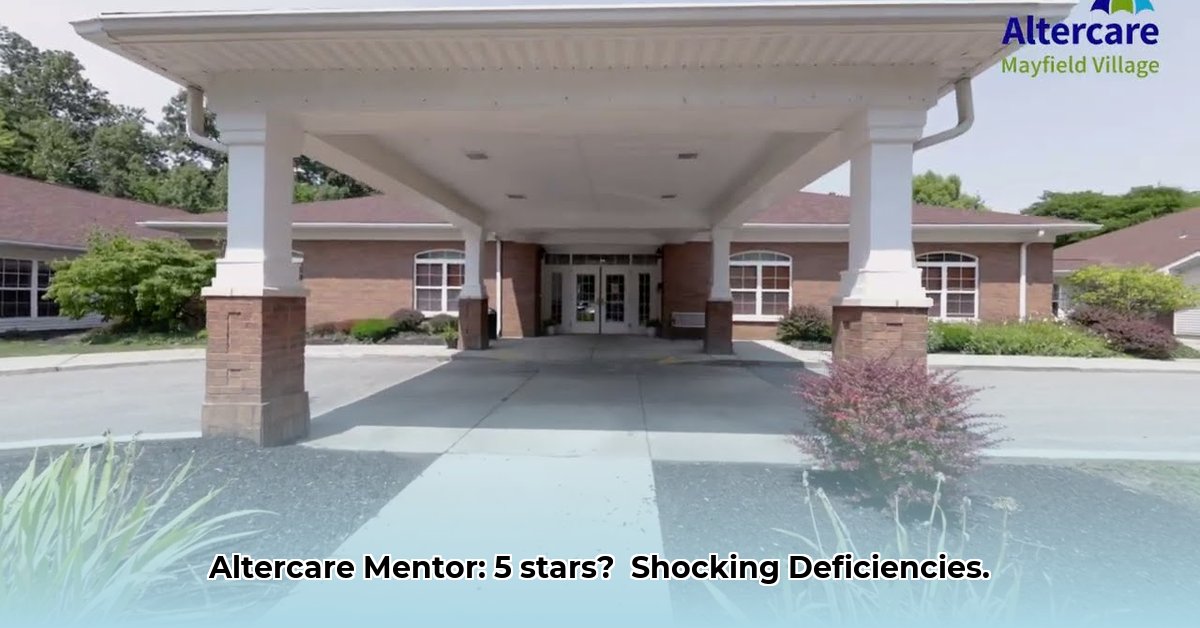
Choosing a nursing home is a weighty decision. Altercare of Mentor, Ohio, presents a complex case. Its five-star Medicare rating suggests exceptional care, yet inspection reports reveal significant deficiencies, raising serious questions about resident safety and well-being. This investigation delves into the discrepancies, offering insights to help families make informed choices.
The Five-Star Illusion: Deconstructing Medicare's Rating System
Medicare's five-star rating system, while useful, isn't a panacea. It aggregates various metrics, potentially masking critical issues. Altercare's high rating, alongside a reported occupancy rate exceeding 66%, might initially appear positive. However, high occupancy doesn't automatically equate to superior care. It could simply reflect limited alternatives in the area. This highlights the need to look beyond simplistic ratings and examine the underlying data. How can a facility with such a high rating struggle to meet core care standards? It demands thorough investigation.
Inspection Reports: Unveiling Critical Deficiencies
Reports from 2018 (or possibly 2019 – a discrepancy we'll address later) paint a contrasting narrative. These reports detail deficiencies concerning resident safety and well-being, raising concerns about potential abuse, neglect, or exploitation. The lack of readily available detailed information is alarming. We need transparency. What specific incidents occurred? What corrective actions were taken? The absence of this crucial information hinders a complete assessment of Altercare's performance. A high rating alone shouldn't obfuscate serious safety concerns.
The Date Discrepancy: A Cloud of Uncertainty
A major challenge in assessing Altercare is the conflicting information regarding the inspection date. Some sources cite March 2018, others May 2019. This inconsistency raises serious questions about the reliability of the reporting process itself. Was this a simple administrative error? Or does it hint at something more profound? This lack of clarity undermines confidence in the facility’s overall transparency. We urgently need access to the complete, unredacted inspection reports for a proper evaluation.
Financial Viability vs. Quality of Care: A Crucial Distinction
Altercare received over $2.9 million in Medicare payments in 2016. Coupled with high occupancy, this suggests financial stability. However, financial success shouldn't be equated with excellent care. Profitability is not a proxy for resident well-being. We must prioritize the quality of care provided, regardless of the facility's financial status. A facility can be profitable yet fail to meet basic care standards, underscoring the importance of independent verification of quality.
The Urgency of Transparency
The conflict between Altercare's five-star rating and the documented deficiencies demands greater transparency. Families deserve access to the full inspection reports to make informed decisions about their loved ones' care. Regulatory agencies must ensure that reporting standards are clear, consistent, and accessible to the public. The current situation highlights a critical system deficiency and demands immediate attention to improve data accessibility and clarity for families.
Actionable Steps: Empowering Families and Regulators
This situation calls for clear, decisive action. Here's a roadmap for various stakeholders:
1. Families of Residents:
- Demand complete copies of all inspection reports from Altercare and the Ohio Department of Health.
- Compare Altercare with other facilities in the area to assess its relative performance.
- Actively participate in resident care planning and advocate for improved standards.
2. Regulatory Agencies:
- Launch a full investigation into the inconsistencies regarding the inspection dates.
- Enhance oversight of facilities with conflicting ratings, ensuring accountability.
- Develop clearer guidelines and improve public access to comprehensive inspection reports.
3. Altercare Management:
- Address all deficiencies cited in the inspection reports immediately and transparently.
- Implement comprehensive corrective action plans and make them publicly available.
- Invest in staff training to improve the quality of care provided.
Assessing the Risks: A Preliminary Analysis
The table below presents a preliminary risk assessment based on the available information. Further investigation is crucial for a definitive conclusion.
| Risk Factor | Likelihood | Impact | Mitigation Strategy |
|---|---|---|---|
| Resident Safety Deficiencies | High | High | Immediate corrective actions; rigorous staff retraining; enhanced monitoring systems |
| Inspection Data Discrepancies | Medium | Medium | Thorough investigation; improved record-keeping; independent audit |
| High Prevalence of Chronic Illness | Possibly High | Medium to High | Adequate staffing with specialized training; enhanced care planning |
| Certification Risk | Medium | High | Full regulatory compliance; robust quality improvement programs |
This is not an exhaustive list, and the assessment requires further detailed investigation. The current information reveals substantial cause for concern.
Reconciling Conflicting Information: A Guide for Families
Choosing a nursing home requires a multifaceted approach. Don't rely solely on a single metric. Use the following steps:
- Obtain the full inspection report: Access the complete report directly from the relevant regulatory agencies to gain a comprehensive understanding.
- Analyze the details: Identify specific deficiencies and evaluate their severity and the facility's response.
- Consider the timing: Compare the inspection date to the period covered by the star rating.
- Seek external opinions: Talk to other families and consider independent reviews.
- Conduct an in-person visit: Observe the facility's environment and interact with staff and residents.
Choosing a nursing home is a personal journey. This analysis provides tools for navigating conflicting information and making informed choices. Do not hesitate to advocate for your loved ones. Their well-being demands transparency and accountability from all stakeholders.